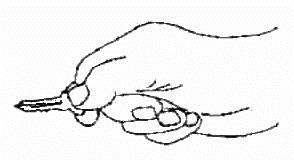December Safety Tip
Arm positioning and grip are important aspects of lifting. Unless the parts are very small, you should lift with both hands and keep your hands underneath the part so your palms are facing up. This will engage the biceps and take pressure off of the forearm. Pinch grips/precision grips using the thumb, index, and middle fingers are very stressful to the muscles. Instead of a pinch grip, lift the part with your whole hand or with two hands. As you handle materials and parts today, try to look for times where you normally use a pinch grip. Can you change the grip?
“For hand tool design, many factors should be considered before purchasing hand tools. Consider the following recommended design features:
- For handle design:
- Preferable is 5” length with a 4” minimum
- If gloves are worn add 0.5” for handle length
- If a power grip (i.e., full grasp) is used then the diameter should be about 1.5”
- For a precision grip (thumb and index and middle fingers) then have a 0.5” diameter
- If the tool has two handles, the inside width between the handles should be 2.5” to 3.5”
- The handle should provide the greatest force-bearing area as possible (i.e., a good portion of the hand should be on the tool)
- Avoid smooth or high polish surface (such as smooth wood, bare metal handles). Textured, padded handles are preferred
- Avoid form-fitting finger recesses (more than 1/8”)
- The handle should have good electrical and heat insulation
- Doesn’t absorb oil, solvents, etc.
- There should be no sharp edges
- The handle should extend beyond the palm (i.e., no handle ending in the palm causing contact stress)
- The above can help the tool be balanced in the hand (helping to prevent awkward deviation postures)
- For tools that insert/press parts together it should have a flange or thumb stop
- Consider bent handles to control wrist deviations
- For twisting or rotation movements have a shallow longitudinal groove
- For pushing/pulling tasks along an axis a slight ripple texture is recommended
- If a tool weighs more than 5 lbs., use a tool balancer device
- The tool should provide sensory feedback
- It should allow for right/left hand options
Another good guide is from NIOSH/CDC: A Guide To Selecting Non-Powered Hand Tools”

